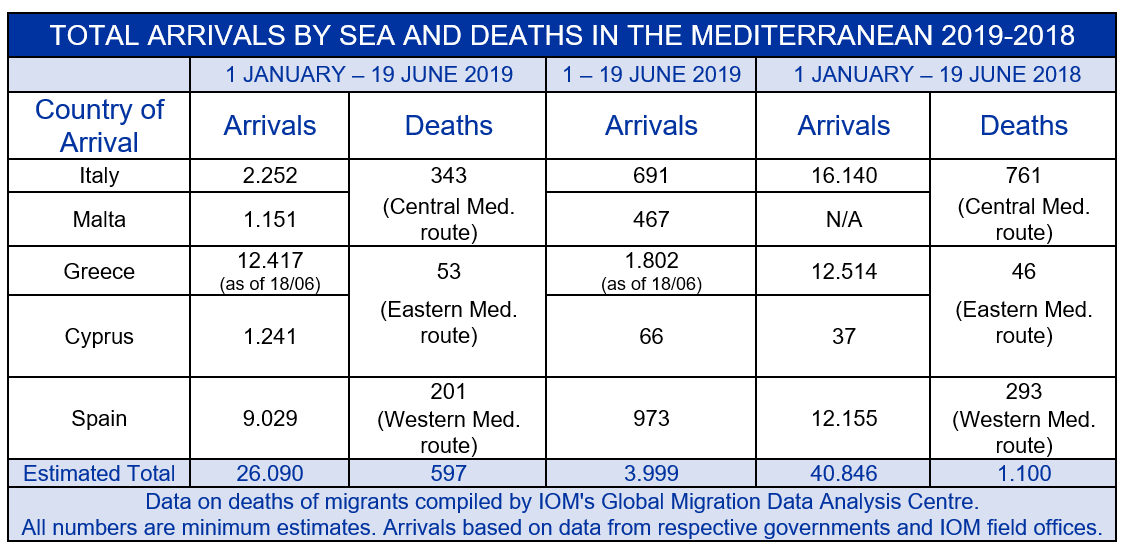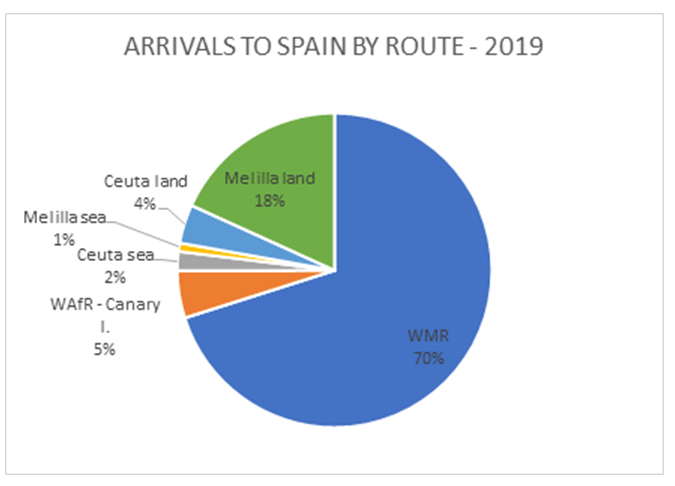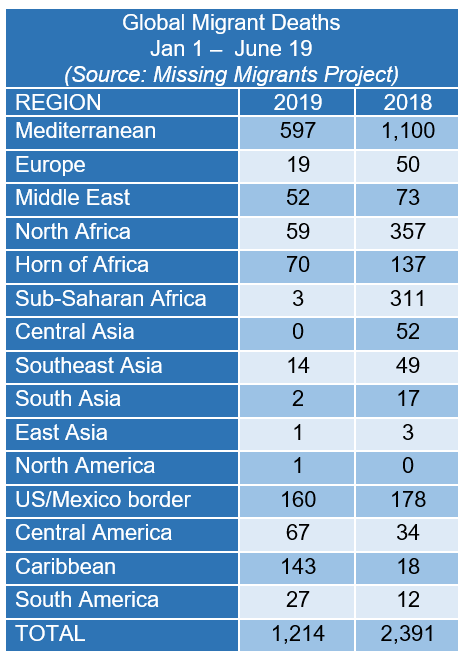-
Who we are
WHO WE AREThe International Organization for Migration (IOM) is part of the United Nations System as the leading inter-governmental organization promoting since 1951 humane and orderly migration for the benefit of all, with 175 member states and a presence in 171 countries.
-
Our Work
Our WorkAs the leading inter-governmental organization promoting since 1951 humane and orderly migration, IOM plays a key role to support the achievement of the 2030 Agenda through different areas of intervention that connect both humanitarian assistance and sustainable development.
What We Do
What We Do
Partnerships
Partnerships
Highlights
Highlights
- Where we work
-
Take Action
Take Action
Work with us
Work with us
Get involved
Get involved
- Data and Research
- 2030 Agenda
Mediterranean Migrant Arrivals Reach 26,090 in 2019; Deaths Reach 597
Geneva – The International Organization for Migration (IOM) reports that 26,090 migrants and refugees have entered Europe by sea through 19 June, roughly a 35 per cent decrease from the 40,846 arriving during the same period last year.
Arrivals to Spain and Greece account for 82 per cent of all irregular arrivals this year across three Mediterranean Sea routes, with the balance arriving in much smaller proportions to Italy, Malta and Cyprus. Arrivals to Greece – the region’s busiest sea destination – are about even in 2019 with those from this same time last year. Arrivals to Spain are about 25 per cent lower than those through this same date in 2018.
Deaths recorded on the three main Mediterranean Sea routes through 170 days of 2019 are at 597 individuals – or just over half the total (1,100 deaths) confirmed during the same period in 2018 (see chart below).
Mediterranean Developments

IOM Greece
IOM Greece’s Christine Nikolaidou reported on Thursday (20/06) that since last Friday (14/06), the Hellenic Coast Guard (HCG) has been involved with at least 13 incidents requiring search and rescue operations off the islands of Lesvos, Samos, Leros, Farmakonisi and Alexandroupoli’s port. The HCG rescued a total of 420 migrants and transferred them to the respective ports.
Those arrivals were among some 734 IOM recorded during the days 13 June through 18 June, bringing to 12,417 the total number of sea arrivals to Greece this year (see chart below).

IOM Spain
IOM Spain’s Ana Dodevska reported on Thursday (20/06) that sea arrivals in the Western Mediterranean are now at 9,029 men, women and children through 12 June. That is well below the total for this same period last year, when 12,155 irregular migrants had arrived in Spain by the Western Mediterranean route.
While Spain was the Mediterranean’s busiest irregular migration route in 2018, activity in these waters appears to have tapered off significantly after a fast start earlier this year. June arrivals this year through almost three weeks are just 973 men, women and children – or just over 50 per day, Dodevska reported. Last year through 30 days of June the total entering Spain for the month was 6,926 – or 230 per day to Spain via this same route.
Last year nearly 60,000 irregular migrants and refugees entered Europe via the Western Mediterranean route. With just over a week remaining before 2019 reaches its midpoint, total arrivals on this route are well under 10,000 (see charts below).

IOM Spain also provided data on landing spots (see below):

IOM Italy
According to IOM Rome’s Flavio Di Giacomo, citing official Ministry of Interior figures, 2,252 migrants have arrived by sea to Italy in 2019. As of 19 June, 3,137 migrants have been returned to Libya in 2019.
Missing Migrants Project
2019 is the sixth year of IOM’s efforts to systematically record deaths on migration routes worldwide through its Missing Migrants Project. Since the beginning of 2014, the project has recorded the deaths of 32,171 individuals, including 1,214 in 2019. Due to the challenges of collecting information about these people and the contexts of their deaths, the true number of lives lost during migration is likely much higher. Missing Migrants Project records should only be viewed as indicative of the risks associated with migration, rather than representative of the true number of deaths across time or geography (see chart below).
This past week was marked by several tragedies in the Mediterranean, where Missing Migrants Project recorded the deaths of 34 people this week. In the Eastern Mediterranean, a boat sank on 17 June off the coast of Bodrum, Turkey. The Turkish Coast Guard rescued 31 survivors and recovered the bodies of 12 people from the boat, including two women, seven men and three children. The nationalities of only six people are known: among the deceased, there were four Syrian nationals (a mother and her three children) and two Somalis.
In the Western Mediterranean, a boat capsized on 19 June in the Alborán Sea, between Spain and Morocco. A commercial vessel found the sinking boat 11 nautical miles north of Cape Tres Forcas, near Melilla, Spain, and rescued 27 survivors, who reported that 22 people had been lost at sea. The survivors include 24 men, two women and an 11-year-old girl. There is no information on the nationalities, sex or age of the deceased. Spanish rescue services coordinated the medical evacuation of 6 survivors in critical condition to the hospital in Almería, while the remaining 21 people were transferred to Motril, Granada.
Additionally, the MMP team received data from the Pima County Office of the Medical Examiner regarding remains recovered in the Sonora desert, which covers large parts of this county located in south-central Arizona, USA. It is unclear how many people die crossing the US-Mexico border through the desert, as many bodies are never recovered. But in Pima County alone, officials have recovered the remains of 58 people since the start of 2019, including 15 just in the month of May.
In total, at least 398 people have lost their lives in the Americas in 2019, compared with 232 recorded through this point in 2018.
Missing Migrants Project data are compiled by IOM staff based at its Global Migration Data Analysis Centre but come from a variety of sources, some of which are unofficial. To learn more about how data on migrants’ deaths and disappearances are collected, click here.

For latest arrivals and fatalities in the Mediterranean, click here. Learn more about the Missing Migrants Project.
See contacts here.
